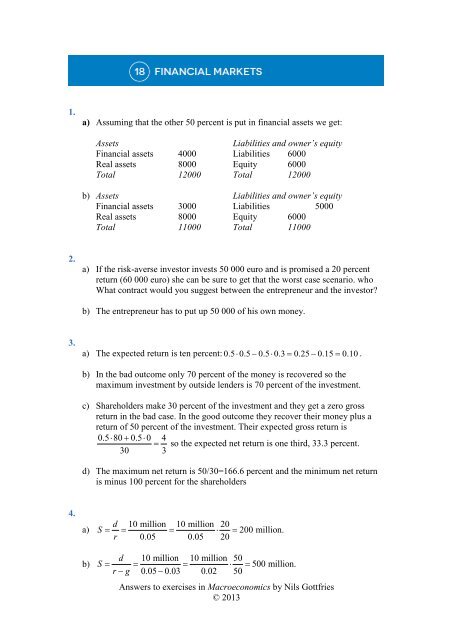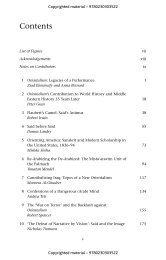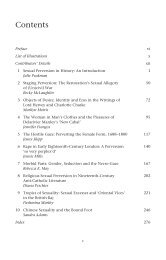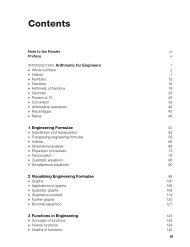Answers to exercises in Macroeconomics by Nils Gottfries ... - Palgrave
Answers to exercises in Macroeconomics by Nils Gottfries ... - Palgrave
Answers to exercises in Macroeconomics by Nils Gottfries ... - Palgrave
Create successful ePaper yourself
Turn your PDF publications into a flip-book with our unique Google optimized e-Paper software.
1.<br />
a) Assum<strong>in</strong>g that the other 50 percent is put <strong>in</strong> f<strong>in</strong>ancial assets we get:<br />
Assets<br />
Liabilities and owner’s equity<br />
F<strong>in</strong>ancial assets 4000 Liabilities 6000<br />
Real assets 8000 Equity 6000<br />
Total 12000 Total 12000<br />
b) Assets Liabilities and owner’s equity<br />
F<strong>in</strong>ancial assets 3000 Liabilities 5000<br />
Real assets 8000 Equity 6000<br />
Total 11000 Total 11000<br />
2.<br />
a) If the risk-averse <strong>in</strong>ves<strong>to</strong>r <strong>in</strong>vests 50 000 euro and is promised a 20 percent<br />
return (60 000 euro) she can be sure <strong>to</strong> get that the worst case scenario. who<br />
What contract would you suggest between the entrepreneur and the <strong>in</strong>ves<strong>to</strong>r?<br />
b) The entrepreneur has <strong>to</strong> put up 50 000 of his own money.<br />
3.<br />
a) The expected return is ten percent: 0.5⋅0.5 −0.5⋅ 0.3 = 0.25 − 0.15 = 0.10 .<br />
b) In the bad outcome only 70 percent of the money is recovered so the<br />
maximum <strong>in</strong>vestment <strong>by</strong> outside lenders is 70 percent of the <strong>in</strong>vestment.<br />
c) Shareholders make 30 percent of the <strong>in</strong>vestment and they get a zero gross<br />
return <strong>in</strong> the bad case. In the good outcome they recover their money plus a<br />
return of 50 percent of the <strong>in</strong>vestment. Their expected gross return is<br />
0.5⋅ 80 + 0.5⋅0 4<br />
= so the expected net return is one third, 33.3 percent.<br />
30 3<br />
d) The maximum net return is 50/30=166.6 percent and the m<strong>in</strong>imum net return<br />
is m<strong>in</strong>us 100 percent for the shareholders<br />
4.<br />
a)<br />
b)<br />
d 10 million 10 million 20<br />
S = = = ⋅ = 200 million.<br />
r 0.05 0.05 20<br />
d 10 million 10 million 50<br />
S = 500 million.<br />
r−g<br />
= 0.05 −0.03<br />
= 0.02 ⋅ 50<br />
=<br />
<strong>Answers</strong> <strong>to</strong> <strong>exercises</strong> <strong>in</strong> <strong>Macroeconomics</strong> <strong>by</strong> <strong>Nils</strong> <strong>Gottfries</strong><br />
© 2013
c) Let the risk of bankruptcy be p. Then we can modify the calculation <strong>in</strong> the<br />
text:<br />
( ) ( )<br />
( )<br />
2 3<br />
2 3<br />
2 3 4<br />
d 1+ g d 1+ g d 1+<br />
g d<br />
S = + 1− p + 1− p + 1 − p ...<br />
1+ r 1+ r 1+ r 1+<br />
r<br />
( ) ( )<br />
( )<br />
( ) ( )<br />
( )<br />
( 1− p)( 1+ g) ( 1− p)( 1+ g) ( 1− p)( 1+<br />
g)<br />
2 3<br />
d ⎛<br />
⎛ ⎞ ⎛ ⎞ ⎞<br />
= 1 + + ⎜ ⎟ + ⎜ ⎟ ..<br />
1+ r⎜<br />
1+ r 1+ r 1+<br />
r ⎟<br />
⎝<br />
⎝ ⎠ ⎝ ⎠ ⎠<br />
d 1<br />
d d d<br />
= ⋅ = = ≈<br />
1+ r ( 1− p)( 1+<br />
g)<br />
1+ r−1− g+ p+ pg r− g+ p+ pg r− g+<br />
p<br />
1−<br />
1+<br />
r<br />
10 million 10 million 100<br />
= = ⋅ ≈ 333.3 million.<br />
0.05 − 0.03 + 0.01 0.03 100<br />
5. Probably not. The comb<strong>in</strong>ation of liquid debt and illiquid lend<strong>in</strong>g makes banks<br />
vulnerable <strong>to</strong> bank runs if confidence is shaken and unexpected losses will always<br />
occur. With high reliance on wholesale f<strong>in</strong>anc<strong>in</strong>g, banks can still be subject <strong>to</strong><br />
bank runs.<br />
6. See section 18.7.<br />
7. What matters for aggregate demand accord<strong>in</strong>g <strong>to</strong> the theory presented <strong>in</strong> Chapters<br />
3 and 4 is the expected real <strong>in</strong>terest rate that firm and households pay on their<br />
loans, and get on their sav<strong>in</strong>gs. If the marg<strong>in</strong> <strong>in</strong>creases between banks’ lend<strong>in</strong>g<br />
rates and the repo (or federal funds) rate it makes sense <strong>to</strong> take account of that<br />
when sett<strong>in</strong>g the <strong>in</strong>terest rate. One could use the Taylor rule but subtract the<br />
<strong>in</strong>terest rate marg<strong>in</strong> that is <strong>in</strong> excess of what it normally is.<br />
8. The Taylor rule that was presented <strong>in</strong> Chapter 10 is:<br />
i = 0.02 + π + 0.5 π − 0.02 + 0.5Y<br />
.<br />
( ) ˆ<br />
a) i = 0.02 + 0 + 0.5( 0 −0.02 ) −.5⋅ 0.04 = 0.02 −0.01− 0.02 = − 0.01<br />
b) i = 0.02 − 0.01+ 0.5( −0.01−0.02)<br />
−0.5⋅ 0.04 = 0.02 −0.01−0.015 − 0.02 =−0.025<br />
c) The <strong>in</strong>terest rate cannot be far below zero because then firms and households<br />
prefer <strong>to</strong> hold cash/monetary base with zero <strong>in</strong>terest.<br />
<strong>Answers</strong> <strong>to</strong> <strong>exercises</strong> <strong>in</strong> <strong>Macroeconomics</strong> <strong>by</strong> <strong>Nils</strong> <strong>Gottfries</strong><br />
© 2013
9. Normally this is true because lower wage <strong>in</strong>creases imply lower <strong>in</strong>flation and the<br />
central bank reacts <strong>to</strong> lower <strong>in</strong>flation <strong>by</strong> reduc<strong>in</strong>g the <strong>in</strong>terest rate more than the<br />
decrease <strong>in</strong> <strong>in</strong>flation. Thus we get a lower real rate and higher aggregate demand.<br />
But if the <strong>in</strong>terest rate is at the zero lower bound, the central bank cannot reduce<br />
the <strong>in</strong>terest rate further. Then, lower wage <strong>in</strong>creases and lower <strong>in</strong>flation can lead<br />
<strong>to</strong> higher real <strong>in</strong>terest rates and lower aggregate demand and employment.<br />
10. We use the Taylor rule i 0.02 π 0.5( π 0.02) 0.5Yˆ<br />
= + + − + .<br />
∆W<br />
∆E<br />
The equation for <strong>in</strong>flation from Chapter 9 is π = − .<br />
W E<br />
Thus we have<br />
⎛∆W<br />
∆E⎞<br />
i = 0.01+ 1.5 0.5Yˆ<br />
⎜ − ⎟+<br />
⎝ W E ⎠<br />
The real <strong>in</strong>terest rate is m<strong>in</strong>imized when the nom<strong>in</strong>al <strong>in</strong>terest rate is zero (see Fig.<br />
10.6). Sett<strong>in</strong>g i=0 we get:<br />
( Yˆ)<br />
∆W = 1 −0.01− 0.5 + ∆E = −0.007<br />
− 1 Yˆ<br />
+<br />
∆E<br />
W 1.5 E 3 E<br />
If productivity growth is 2.7 percent and the output gap is zero, a wage <strong>in</strong>crease<br />
equal <strong>to</strong> 2 percent per year will m<strong>in</strong>imize the real <strong>in</strong>terest rate and maximize job<br />
growth. Lower wage growth will raise the real <strong>in</strong>terest rate because the central<br />
bank cannot reduce the nom<strong>in</strong>al <strong>in</strong>terest rate further.<br />
<strong>Answers</strong> <strong>to</strong> <strong>exercises</strong> <strong>in</strong> <strong>Macroeconomics</strong> <strong>by</strong> <strong>Nils</strong> <strong>Gottfries</strong><br />
© 2013
















